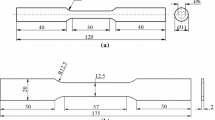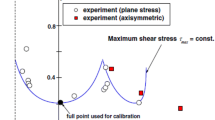Abstract
A phenomenological ductile fracture model is proposed by a careful consideration of void nucleation, growth and coalescence during plastic deformation. Within the model framework, void nucleation is controlled by an equivalent plastic strain function. Void growth takes place through two ways, namely void dilation and void elongation, which are characterized by the normalized hydrostatic stress and normalized maximum shear stress, respectively. Void coalescence is characterized by the maximum shear stress. Aluminum alloy (AA) 6016-T6 sheets are selected to conduct ductile fracture (DF) experiments on specimens with different geometries, which can cover a wide range of stress states from simple shear to balanced biaxial tension. Subsequently, the new DF model is calibrated by using a robust hybrid numerical-experimental approach with a three-dimensional (3D) fracture surface constructed for AA 6016-T6. Ductile fracture data of other two aluminum alloys (AA 2024-T351 and AA 5083-O) are also used to evaluate DF model performance by establishing their 3D fracture surfaces. Finally, a cup drawing test is conducted and simulated as a case study showing how an applicable way of using the new model. Furthermore, the predictive accuracy of the proposed DF model for fracture initiation is compared with other three uncoupled models (modified Mohr–Coulomb criterion (MMC), Lou-Yoon-Huh model and Mu-Zang model) by ABAQUS/Explicit with a user subroutine (VUMAT), which shows a good performance of the proposed DF model.

Copyright 2011, with permission from Elsevier

Copyright 2018, with permission from Elsevier
















Similar content being viewed by others
Reference
M.B. Gorji and D. Mohr, Predicting Shear Fracture of Aluminum 6016–T4 During Deep Drawing: Combining Yld-2000 Plasticity With Hosford-Coulomb Fracture Model, Int. J. Mech. Sci., 2018, 137, p 105–120.
P.N.C. Leonardo, J.P. Magrinho, I.M.F. Bragança, M.B. Silva, C.M.A. Silva and P.A.F. Martins, Formability Limits in Sheet-Bulk Forming, Int. J. Mach. Tool Manu., 2020, 149, p 1035.
A. Roatta, M. Stout and J.W. Signorelli, Determination of the Forming-Limit Diagram from Deformations Within Necking Instability: A Digital Image Correlation-Based Approach, J. Mater. Eng. Perform., 2020, 29(6), p 4018–4031.
F. Ozturk and D. Lee, A New Methodology for Ductile Fracture Criteria to Predict the Forming Limits, J. Mater. Eng. Perform., 2007, 16(2), p 224–228.
H. Li, M.W. Fu, J. Lu and H. Yang, Ductile Fracture: Experiments and Computations, Int. J. Plast., 2011, 27(2), p 147–180.
A.L. Gurson, Continuum Theory of Ductile Rupture by Void Nucleation and Growth: Part I-Yield Criteria and Flow Rules for Porous Ductile Media, J. Eng. Mater. Technol., 1977, 99(1), p 2–15.
C.C. Chu and A. Needleman, Void Nucleation Effects in Biaxially Stretched Sheets, J. Eng. Mater. Technol., 1980, 120(3), p 249–256.
A. Needleman and V. Tvergaard, An Analysis of Ductile Rupture in Notched Bars, J. Mech. Phys. Solids, 1984, 32(6), p 461–490.
K. Nahshon and J.W. Hutchinson, Modification of the Gurson Model for Shear Failure, Eur. J. Mech. A-Solids, 2008, 27, p 1–17.
L. Xue, Constitutive Modeling of Void Shearing Effect in Ductile Fracture of Porous Materials, Eng. Fract. Mech., 2008, 75, p 3343–3366.
J. Lemaitre, A Continuous Damage Mechanics Model for Ductile Fracture, J. Eng. Mater. Technol., 1985, 107(1), p 83–89.
T.S. Cao, J.M. Gachet, P. Montmitonnet and P.O. Bouchard, A Lode-Dependent Enhanced Lemaitre Model For Ductile Fracture Prediction at Low Stress Triaxiality, Eng. Fract. Mech., 2014, 124–125, p 80–96.
A.M. Freudenthal, The Inelastic Behavior of Engineering Materials and Structures, John Wiley & Sons, NewYork, 1950.
M. Oyane, T. Sato, K. Okimoto and S. Shima, Criteria for Ductile Fracture And Their Applications, J. Mech. Work. Technol., 1980, 4, p 65–81.
J.R. Rice and D.A. Tracey, On the Ductile Enlargement of Voids in Triaxial Stress Fields, J. Mech. Phys. Solids, 1969, 17, p 201–217.
M. Cockcroft and D. Latham, Ductility and the Workability of Metals, J. Inst. Met., 1968, 96(1), p 33–39.
P. Brozzo, B. Deluca, R. Rendina A New Method for the Prediction of Formability Limits in Metal Sheets. Proceedings of the 7th Biennial Conference of the International Deep Drawing Research Group. Amsterdam, Netherlands, 1972
H.N. Han and K. Kim, A Ductile Fracture Criterion in Sheet Metal Forming Process, J. Mater. Process. Technol., 2003, 142(1), p 231–238.
Y. Bao and T. Wierzbicki, On the Cut-Off Value of Negative Triaxiality for Fracture, Eng. Fract. Mech., 2005, 72(7), p 1049–1069.
Y. Bai and T. Wierzbicki, Application of Extended Mohr-Coulomb Criterion to Ductile Fracture, Int. J. Fract., 2009, 161, p 1–20.
Y.S. Lou, H. Huh, S.J. Lim and K. Pack, New Ductile Fracture Criterion for Prediction of Fracture Forming Limit Diagrams of Sheet Metals, Int. J. Solids Struct., 2012, 49, p 3605–3615.
Y. Lou, J.W. Yoon and H. Huh, Modeling of Shear Ductile Fracture Considering a Changeable Cut-Off Value for Stress Triaxiality, Int. J. Plast., 2014, 54, p 56–80.
D. Mohr and S.J. Marcadet, Micromechanically-Motivated Phenomenological Hosford-Coulomb Model for Predicting Ductile Fracture Initiation at Low Stress Triaxialities, Int. J. Solids Struct., 2015, 67–68, p 40–55.
L. Mu, Y. Zang, Y. Wang, X.L. Li and P.M. Araujo Stemler, Phenomenological Uncoupled Ductile Fracture Model Considering Different Void Deformation Modes For Sheet Metal Forming, Int. J. Mech. Sci., 2018, 141, p 408–423.
L. Mu, Z. Jia, Z.W. Ma, F.H. Shen, Y.K. Sun and Y. Zang, A Theoretical Prediction Framework for the Construction of a Fracture Forming Limit Curve Accounting For Fracture Pattern Transition, Int. J. Plast., 2020, 129, p 102706.
Q. Hu, X.F. Li, X.H. Han and J. Chen, A New Shear and Tension Based Ductile Fracture Criterion: Modeling and Validation, Eur. J. Mech. A-Solids, 2017, 66, p 370–386.
A.S. Argon, J. Im and R. Safoglu, Cavity Formation From Inclusions in Ductile Fracture, Metall. Trans. A, 1975, 6(4), p 825–837.
F.M. Beremin, Cavity Formation From Inclusions in Ductile Fracture of A508 Steel, Metall. Trans. A, 1981, 12, p 723–731.
B.J. Lee and M.E. Mear, Stress Concentration Induced by an Elastic Spheroidal Particle in a Plastically Deforming Solid, J. Mech. Phys. Solids, 1999, 47, p 1301–1336.
S.H. Goods and L.M. Brown, Overview No. 1: The Nucleation of Cavities by Plastic Deformation, Acta Metall., 1979, 27(1), p 1–15.
A. Needleman and J.R. Rice, Limits to ductility set by plastic flow localization, Mechanics of Sheet Metal Forming: Material Behavior And Deformation Analysis. D.P. Koistinen, N.M. Wang Ed., Springer, Boston, 1978, p 237–267
G. Le Roy, J.D. Embury, G. Edwards and M.F. Ashby, A Model of Ductile Fracture Based on the Nucleation and Growth of Voids, Acta Metall., 1981, 29, p 1509–1522.
C. Landron, O. Bouaziz, E. Maire and J. Adrien, Characterization and Modeling of Void Nucleation by Interface Decohesion in Dual Phase Steels, Scr. Mater., 2010, 63(10), p 973–976.
E. Maire, O. Bouaziz, M. Di Michiel and C. Verdu, Initiation and Growth of Damage in a Dual-Phase Steel Observed by X-ray Microtomography, Acta Mater., 2008, 56(18), p 4954–4964.
F.A. McClintock, A Criterion for Ductile Fracture by the Growth of Holes, J. Appl. Mech., 1968, 35(2), p 363–371.
B. Marino, F. Mudry and A. Pineau, Experimental Study of Cavity Growth in Ductile Rupture, Eng. Fract. Mech., 1985, 22(6), p 989–996.
R.B. Sills and B.L. Boyce, Void Growth by Dislocation Adsorption, Mater. Res. Lett., 2020, 8(3), p 103–109.
M. Achouri, G. Germain, P. Dal Santo and D. Saidane, Experimental Characterization and Numerical Modeling of Micromechanical Damage Under Different Stress States, Mater. Des., 2013, 50, p 207–222.
R. Kiran and K. Khandelwal, A Coupled Microvoid Elongation and Dilation Based Ductile Fracture Model for Structural Steels, Eng. Fract. Mech., 2015, 145, p 15–42.
A. Weck and D.S. Wilkinson, Experimental Investigation of Void Coalescence in Metallic Sheets Containing Laser Drilled Holes, Acta Mater., 2008, 56(8), p 1774–1784.
P.F. Thomason, A Three-Dimensional Model for Ductile Fracture by the Growth and Coalescence of Microvoids, Acta Metall., 1985, 33(6), p 1087–1095.
C. Tekoglu, Void Coalescence in Ductile Solids Containing Two Populations of Voids, Eng. Fract. Mech., 2015, 147, p 418–430.
L. Brown, J. Embury, Initiation and Growth Of Voids At Second-Phase Particles, Proceedings of the Conference on Microstructure and Design of Alloys, Institute of Metals and Iron and Steel Insitute, London, 1973, pp. 164-169
I. Barsoum and J. Faleskog, Micromechanical Analysis on the Influence of the Lode Parameter on Void Growth and Coalescence, Int. J. Solids Struct., 2011, 48(6), p 925–938.
Y.S. Lou, J.W. Yoon, H. Huh, Q. Chao and J.H. Song, Correlation of the Maximum Shear Stress with Micro-Mechanisms of Ductile Fracture for Metals with High Strength-To-Weight Ratio, Int. J. Mech. Sci., 2018, 146–147, p 583–601.
Z. Jia, B. Guan, Y. Zang, Y. Wang and L. Mu, Modified Johnson-Cook Model of Aluminum Alloy 6016–T6 Sheets at Low Dynamic Strain Rates, Mater. Sci. Eng. A, 2021, 820, p 141565.
L.Y. Qian, G. Fang, P. Zeng and Q. Wang, Experimental and Numerical Investigations into the Ductile Fracture During the Forming of Flat-Rolled 5083-O Aluminum Alloy Sheet, J. Mater. Process. Technol., 2015, 220, p 264–275.
T. Wierzbicki, Y. Bao, Y. Lee and Y. Bai, Calibration and Evaluation of Seven Fracture Models, Int. J. Mech. Sci., 2005, 47(4–5), p 719–743.
Y.S. Lou, L. Chen, T. Clausmeyer, A.E. Tekkaya and J.W. Yoon, Modeling of Ductile Fracture From Shear to Balanced Biaxial Tension for Sheet Metals, Int. J. Solids Struct., 2017, 112, p 169–184.
K. Bandyopadhyay, S.K. Panda, P. Saha and G. Padmanabham, Limiting Drawing Ratio and Deep Drawing Behavior of Dual Phase Steel Tailor Welded Blanks: FE Simulation and Experimental Validation, J. Mater. Process. Technol., 2015, 217, p 48–64.
G.S. Cai, J.L. Yang, Y.F. Yuan, X.Y. Yang, L.H. Lang and S. Alexandrov, Mechanics Analysis of Aluminum Alloy Cylindrical Cup During Warm Sheet Hydromechanical Deep Drawing, Int. J. Mech. Sci., 2020, 174, p 105556.
Acknowledgments
The authors are grateful for the financial support from the National Natural Science Foundation of China (Nos. 51805024, 51805023), and Scientific and Technological Innovation Foundation of Foshan, University of Science and Technology Beijing (USTB), China (Nos. BK20BE007, BK21BE015).
Author information
Authors and Affiliations
Corresponding author
Additional information
Publisher's Note
Springer Nature remains neutral with regard to jurisdictional claims in published maps and institutional affiliations.
Appendix
Appendix
Modified Mohr–Coulomb (MMC) mode could be expressed as follows (Ref 20):
where A, n and C6~C8 are the material constants.
Lou-Yoon-Huh model could be expressed as follows under proportional loading (49):
where C9~C12 are the material constants.
Mu-Zang model could be expressed as follows under proportional loading (Ref 24):
where C13~C15 are the material constants.
Rights and permissions
About this article
Cite this article
Jia, Z., Mu, L., Guan, B. et al. Experimental and Numerical Study on Ductile Fracture Prediction of Aluminum Alloy 6016-T6 Sheets Using a Phenomenological Model. J. of Materi Eng and Perform 31, 867–881 (2022). https://doi.org/10.1007/s11665-021-06248-4
Received:
Revised:
Accepted:
Published:
Issue Date:
DOI: https://doi.org/10.1007/s11665-021-06248-4




